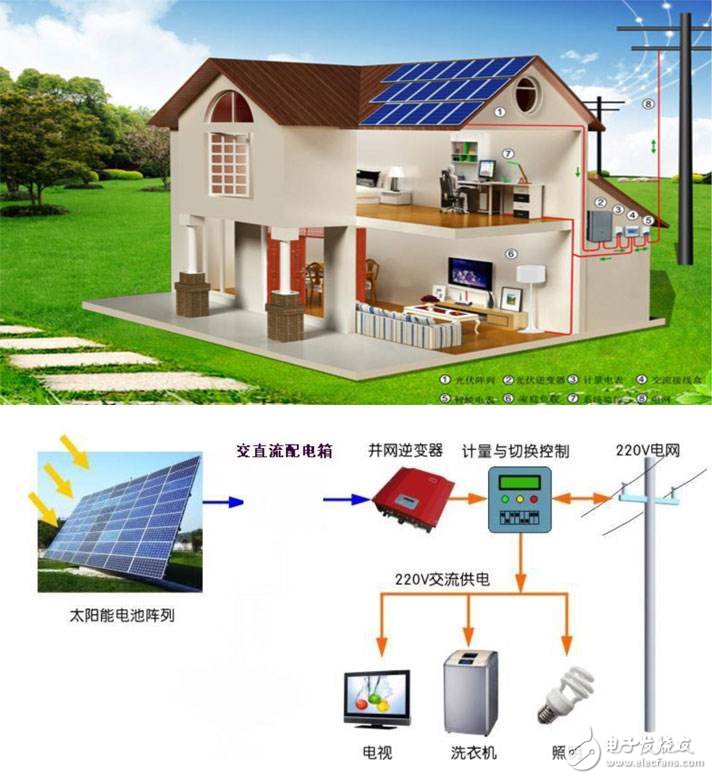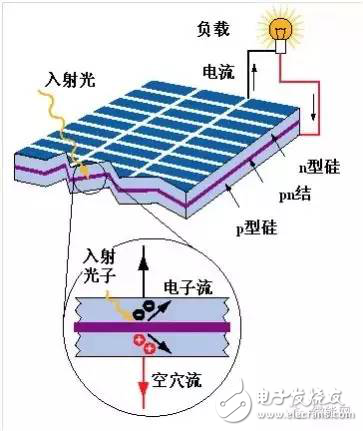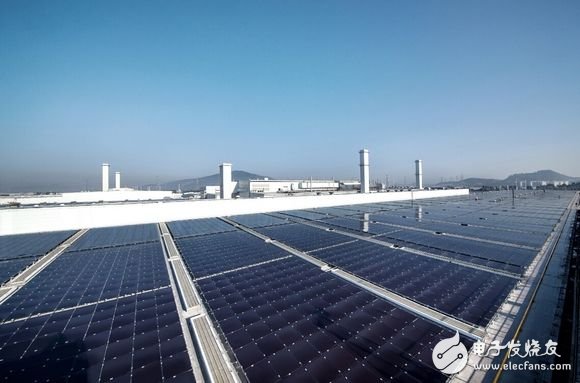Distributed photovoltaic power generation refers to a photovoltaic power generation facility that is built near the user's site and operates in a self-contained mode on the user's side, with excess power on the Internet, and balanced in the distribution system. Distributed photovoltaic power generation follows the principles of local conditions, clean and efficient, distributed layout, and close utilization, making full use of local solar energy resources to replace and reduce fossil energy consumption.
Distributed photovoltaic power generation refers to a distributed generation system that uses photovoltaic modules to directly convert solar energy into electrical energy. It is a new type of comprehensive utilization of power generation and energy with broad development prospects. It advocates the near-generation power generation, the nearest grid connection, the nearby conversion, and the principle of near use, which can not only effectively increase the power generation capacity of photovoltaic power plants of the same scale, but also Effectively solve the problem of power loss in boost and long-distance transportation.
However, distributed power generation also imposes strict requirements on how to maximize solar power generation and how to ensure grid safety. The functionality and stability of photovoltaic inverters are also extremely critical. Distributed power generation follows the principles of local conditions, clean and efficient, distributed layout, and close utilization, making full use of local solar energy resources to replace and reduce fossil energy consumption.
The distributed generation grid-connected mode can be “spontaneous self-use, surplus power on-lineâ€, or “unified purchase and sales†(soldly sold to the grid).
At present, the most widely used distributed photovoltaic power generation system is a photovoltaic power generation project built on the roof of urban buildings. Such projects must be connected to the public grid to provide power to nearby users along with the public grid.

Solar energy is a type of radiant energy that must be converted into electrical energy by means of an energy conversion device. This energy conversion device that converts radiant energy into electrical energy is a solar cell.
Solar cells are devices that use the principle of photoelectric conversion to convert solar radiation into electrical energy through semiconductor materials. This process of photoelectric conversion is usually called "photovoltaic effect", and solar cells are also called "photovoltaic cells".
A photovoltaic cell is a semiconductor device with optical and electrical conversion characteristics. It directly converts solar radiant energy into direct current, which is the most basic unit of photovoltaic power generation. The unique electrical characteristics of photovoltaic cells are based on the incorporation of certain silicon crystals. Elements such as phosphorus or boron, which cause a permanent imbalance in the molecular charge of the material, forming a semiconductor material with special electrical properties, which can generate free charges in semiconductors with special electrical properties under sunlight. Directional movement and accumulation, so that when both ends are closed, electrical energy is generated. This phenomenon is called "photovoltaic effect" and is referred to as photovoltaic effect.
Solar power schematic

The application scope of distributed photovoltaic power generation system: it can be built in rural, pastoral, mountainous areas, developing large, medium and small cities or commercial areas to solve the local users' electricity demand.
solutionDistributed photovoltaic power generation system, also known as decentralized power generation or distributed power supply, refers to the configuration of a small photovoltaic power generation system at or near the user site to meet the needs of specific users and support the economy of existing distribution networks. Run, or both, meet both requirements.
The basic equipment of the distributed photovoltaic power generation system includes photovoltaic cell components, photovoltaic array brackets, DC combiner boxes, DC power distribution cabinets, grid-connected inverters, AC power distribution cabinets, etc. In addition, power supply system monitoring devices and environmental monitoring Device. The operation mode is that under the condition of solar radiation, the solar cell module array of the photovoltaic power generation system converts the electric energy converted by the solar energy into the DC power distribution cabinet through the DC combiner box, and is converted into the AC power supply by the grid-connected inverter. The building's own load, excess or insufficient power is regulated by connecting the grid.
Program characteristicsThe systems are independent of each other and can be controlled by themselves to avoid large-scale blackouts and high safety;
To make up for the shortcomings of the stability of the large power grid, continue to supply power in the event of an accident, and become an important supplement that is indispensable for centralized power supply;
It can monitor the quality and performance of regional power in real time, which is very suitable for power supply to rural, pastoral, mountainous, and developing large, medium and small cities or commercial districts, greatly reducing environmental pressure;
Transmission and distribution losses are low or even no, no need to build a power station, reduce or avoid additional transmission and distribution costs, and low civil and installation costs;
Peak regulation performance is simple and easy to operate;
Due to the small number of systems involved in the operation, the start-stop is fast and easy to implement fully automatic.
What components does the photovoltaic system consist of?The photovoltaic power generation system consists of a photovoltaic array (a photovoltaic array consisting of photovoltaic modules connected in series), a controller, a battery pack, and a DC/AC inverter. The core component of the photovoltaic power generation system is the photovoltaic component, and the photovoltaic component is composed of the photovoltaic cell string, parallel and packaged, which converts the solar light energy directly into electrical energy, and the photovoltaic component generates electricity as direct current, which we can use or The inverter converts it into alternating current for use. From another point of view, the electric energy generated by the photovoltaic system can be used immediately, or the energy storage device such as a battery can be used to store the electric energy and be released at any time as needed.

Photovoltaic power generation has significant energy, environmental protection and economic benefits. It is one of the best quality green energy sources. It can install 1 kW photovoltaic power generation system under average sunshine conditions in China, and can emit 1200 kWh electricity in one year, which can reduce the use of coal (standard coal). The amount is about 400 kg, and the carbon dioxide emission is reduced by about 1 ton. According to the results of the World Wide Fund for Nature (WWF) study, the installation of a 1 square meter photovoltaic power generation system is equivalent to 100 square meters of afforestation in terms of reducing carbon dioxide. Energy is one of the effective means to solve environmental problems such as smog and acid rain.
How do you view the news that “there is a lot of energy when producing photovoltaic modules�Photovoltaic cells do consume a certain amount of energy in their production process, especially industrial silicon purification, high-purity polysilicon production, single crystal silicon rods and polycrystalline silicon ingot production, the energy consumption is high, but the photovoltaic battery has a service life of 20 years. Energy can be continuously generated during the period. It is estimated that under the average sunshine conditions in China, the energy return of photovoltaic power generation system exceeds 15 times of its energy consumption during the whole life.
The energy recovery period of a 1 kW rooftop PV grid-connected system installed at the best tilt angle in Beijing is 1.5-2 years, which is much lower than the lifetime of the PV system. That is to say, the electricity emitted by the photovoltaic system in the first 1.5-2 years is used to offset the energy consumed in the production process. The energy emitted after 1.5-2 years is pure output, so the photovoltaic cell should be evaluated from the perspective of the whole life cycle. Energy consumption.

The production of photovoltaic cell modules includes several industrial chain links of polysilicon, silicon ingot wafers, photovoltaic cells and photovoltaic modules. The reports on related pollution mainly refer to the raw materials of photovoltaic modules, by-products produced in the production of high-purity polysilicon, and the production of high-purity polysilicon. Mainly to use the modified Siemens method, which converts metallurgical grade silicon into trichlorosilane silicon, which is reduced to solar grade polysilicon by hydrogenation, and a by-product silicon chloride is formed. Silicon tetrachloride is decomposed into silicic acid in the presence of moist air. And hydrogen chloride, if improperly handled, it will cause pollution problems, but at present, the modified Siemens method adopted by China's polysilicon production enterprises can achieve closed-loop production, recycling by-products of silicon tetrachloride and tail gas, and achieving clean production.
In December 2010, the state issued the “Plastic Industry Access Conditionsâ€, which stipulated that the recovery rate of silicon tetrachloride and chlorine in the reducing tail gas should not be lower than 98.5% and 99%. Therefore, the mature modified Siemens production technology fully meets the environmental protection requirements. There will be no environmental pollution problems.
What are the application forms of distributed photovoltaic power generation?Distributed photovoltaic power generation includes grid-connected, off-grid and multi-energy complementary microgrids. The grid-connected distributed power generation is mostly used in the vicinity of users. It is generally connected to the medium and low-voltage distribution grids and is used for self-use. When power generation or power is insufficient, electricity is purchased from the power grid, and electricity is sold to the Internet when power is surplus.
Off-grid distributed photovoltaic power generation is mostly used in remote areas and island areas. It is not connected to the large power grid, and uses its own power generation system and energy storage system to directly supply power to the load.
The distributed photovoltaic system can also form a multi-energy complementary micro-electric system with other power generation modes, such as water, wind, light, etc., which can be operated independently as a micro-grid or integrated into the grid.

Shenzhen Kaixuanye Technology Co., Ltd. , https://www.iconline-kxy.com